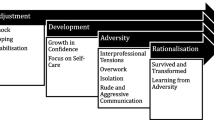Abstract
The first year of practice after medical school is considered to be an essential part of becoming a medical practitioner in Australia. Previous qualitative investigations have investigated a number of significant aspects of this early stage of professional development. This qualitative study explores experiences and developing professional identities during internship. Thirty interns and six intern supervisors were interviewed from three different Australian states. Grounded theory techniques were used to develop three key themes: internship-as-participation, internship-as-progression, and conflicts, parallels, disturbances and outliers. Key findings were: the important balance between support from colleagues and development through taking independent responsibility; and the strength of the view of internship as part of a ‘natural progression’, an inevitable evolution through the stages of medical training.


Similar content being viewed by others
References
Beard, J., Strachan, A., & Davies, H. (2005). Developing an education and assessment framework for the foundation programme. Medical Education, 39(8), 841–851.
Benner, P. (2004). Using the Dreyfus model of skill acquisition to describe and interpret skill acquisition and clinical judgment in nursing practice and education. Bulletin of Science, Technology & Society, 24(3), 188–199.
Bleakley, A. (2002). Pre-registration house officers and ward based learning: A ‘new apprenticeship’ model. Medical Education, 36, 9–15.
Brennan, N., Corrigan, O., Allard, J., Archer, J., Barnes, R., et al. (2010). The transition from medical student to junior doctor: Today’s experiences of tomorrow’s doctors. Medical Education, 44(5), 449–458.
Engestrom, Y. (2009). Expansive learning: Toward an activity-theoretical reconceptualization. In K. Illeris (Ed.), Contemporary theories of learning (pp. 53–73). Oxon: Routledge.
Fuller, A., Hodkinson, H., Hodkinson, P., & Unwin, L. (2005). Learning as peripheral participation in communities of practice: A reassessment of key concepts in workplace learning. British Educational Research Journal, 31(1), 49–68.
Graham, I. S., Gleason, A. J., Keogh, G. W., Paltridge, D., Rogers, I. R., Walton, M., et al. (2007). Australian curriculum framework for junior doctors. Medical Journal of Australia, 186(7 Suppl), S14–S19.
Iedema, R., Brownhill, S., Haines, M., Lancashire, B., Shaw, T., & Street, J. (2010). ‘Hands on, hands off’: A model of clinical supervision that recognises trainees’ need for support and independence. Australian Health Review, 34(3), 286–291.
Illing, J., Morrow, G., Kergon, C., Burford, B., Spencer, J., et al. (2008). How prepared are medical graduate to begin practice. Final report for the GMC education committee. London: GMC.
Lave, J., & Wenger, E. (1991). Situated learning: Legitimate peripheral participation. Cambridge: Cambridge University Press.
Lawson, M., & Bearman, M. (2007a, released 2010). Summary report: Surveys, focus groups and interviews. Australian Medical Education Study. Commonwealth of Australia. http://www.deewr.gov.au/HigherEducation/Publications/HEReports/Documents/AMES-8.pdf.
Lawson, M., & Bearman, M. (2007b, released 2010). Focus group and interview: Medical students, recent medical graduates, employers and clinical trainers Australian Medical Education Study, Commonwealth of Australia. http://www.deewr.gov.au/HigherEducation/Publications/HEReports/Documents/AMES-6.pdf.
Lawson, M., Bearman, M., & Byrne, C. (2007a, released 2010). Survey report: Medical students, recent medical graduates, Employers and Clinical Trainer Australian Medical Education Study, Commonwealth of Australia. http://www.deewr.gov.au/HigherEducation/Publications/HEReports/Documents/AMES-4-5.pdf.
Lawson, M., Bearman, M., & Jones, A. (2007b, released 2010). Intern case study report: Interns and supervisors, Australian Medical Education Study, Commonwealth of Australia. http://www.deewr.gov.au/HigherEducation/Publications/HEReports/Documents/AMES-7.pdf.
Lempp, H., Cochrane, M., Seabrook, M., & Rees, J. (2004). Impact of educational preparation on medical students in transition from final year to PRHO year: A qualitative evaluation of final-year training following the introduction of a new Year 5 curriculum in a London medical school. Medical Teacher, 26(3), 276–278.
Lempp, H., Seabrook, M., Cochrane, M., & Rees, J. (2005). The transition from medical student to doctor: Perceptions of final year students and preregistration house officers related to expected learning outcomes. International Journal of Clinical Practice, 59(3), 324–329.
Monrouxe, L. V. (2009). Negotiating professional identities: Dominant and contesting narratives in medical students’ longitudinal audio diaries. Current Narratives, 1(2009), 41–59.
Monrouxe, L. V. (2010). Identity, identification and medical education: Why should we care? Medical Education, 44(1), 40–49.
O’Neill, P., Jones, A., Willis, S. C., & McArdle, P. J. (2003). Does a new undergraduate curriculum based on tomorrow’s doctors prepare house officers better for their first post? A qualitative study of the views of pre-registration house officers using critical incidents. Medical Education, 37(12), 1100–1108.
Prince, K., Van de Wiel, M., Van der Vleuten, C., Boshuizen, H., & Scherpbier, A. (2004). Junior doctors’ opinions about the transition from medical school to clinical practice: A change of environment. Education for Health, 17(3), 323–331.
Sheehan, D., Wilkinson, T., & Billet, S. (2005). Intern’s participation and learning in clinical environments in a New Zealand hospital. Academic Medicine, 80(3), 302–308.
Strauss, A. L., & Corbin, J. (1998). Basics of qualitative research: Techniques and procedures for developing grounded theory (2nd ed.). Thousand Oaks: Sage Publications.
Wenger, E. (1998). Communities of practice: Learning, meaning, and identity. Cambridge: Cambridge University Press.
Wilkinson, T. J., & Harris, P. (2002). The transition out of medical school; a qualitative study of descriptions of borderline trainee interns. Medical Education, 36(5), 466–471.
Acknowledgments
We would like to acknowledge the contribution of: Beverley Bird; Samantha Thomas and team; and Fiona Williams. We would also like to thank the Associate Editor and the three anonymous reviewers for their comments. The data in the study was collected for the Australian Medical Education Study, funded by Commonwealth of Australia.
Author information
Authors and Affiliations
Corresponding author
Rights and permissions
About this article
Cite this article
Bearman, M., Lawson, M. & Jones, A. Participation and progression: new medical graduates entering professional practice. Adv in Health Sci Educ 16, 627–642 (2011). https://doi.org/10.1007/s10459-011-9284-5
Received:
Accepted:
Published:
Issue Date:
DOI: https://doi.org/10.1007/s10459-011-9284-5



